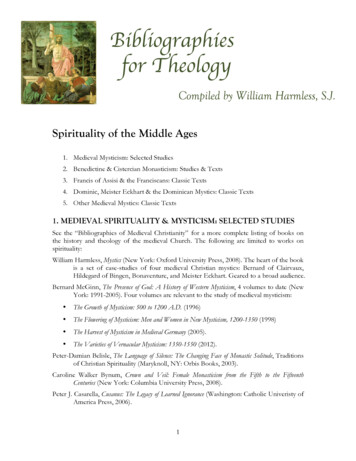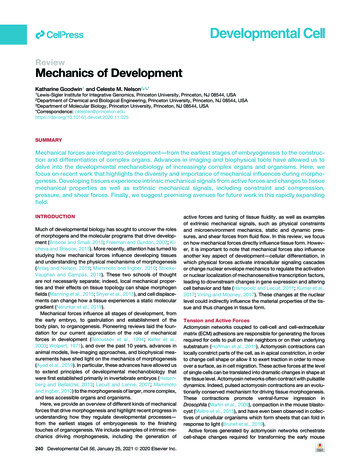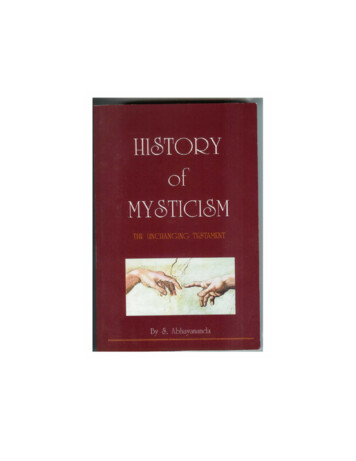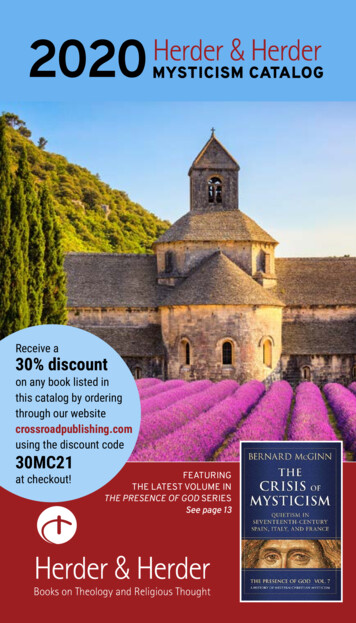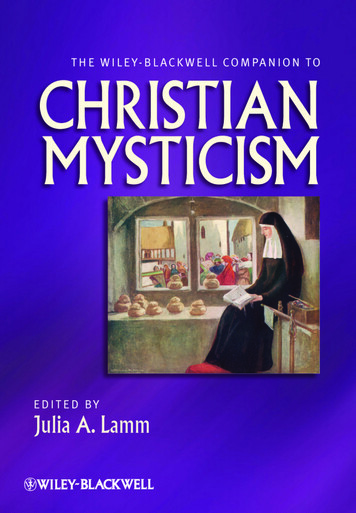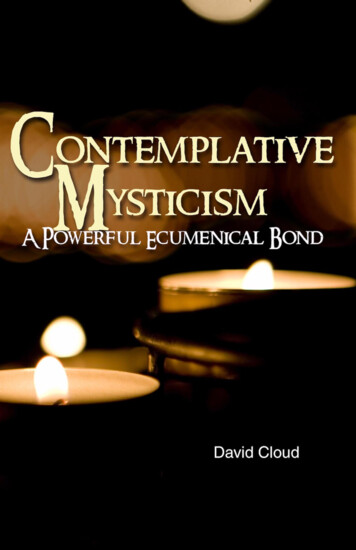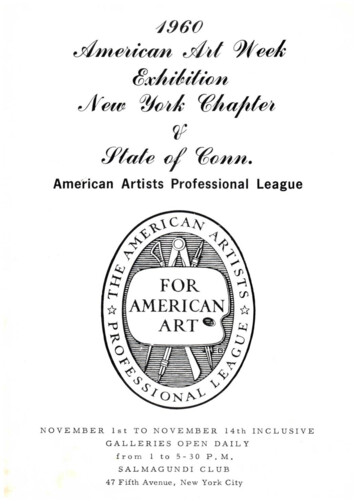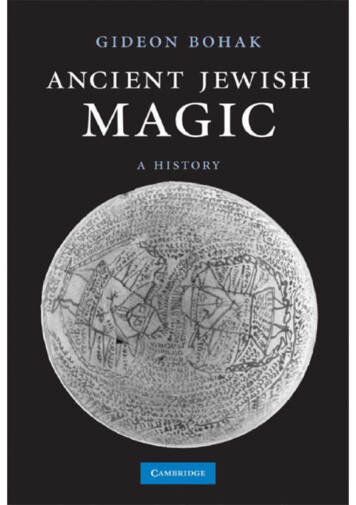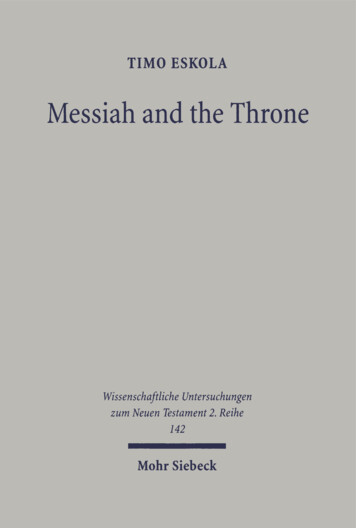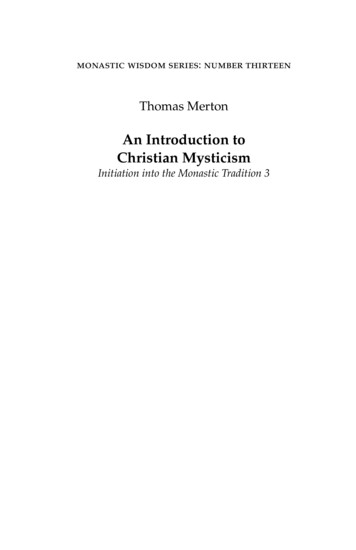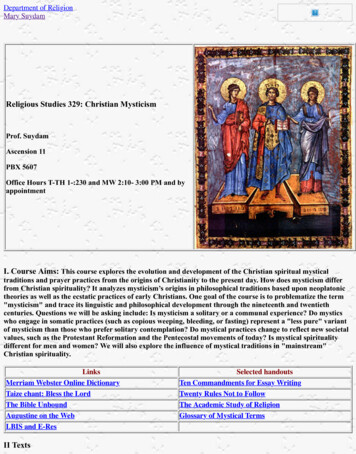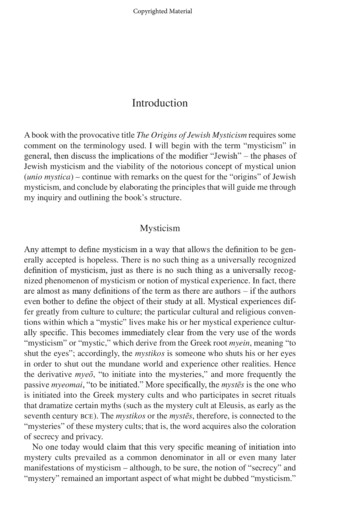
Transcription
Copyrighted MaterialIntroductionA book with the provocative title The Origins of Jewish Mysticism requires somecomment on the terminology used. I will begin with the term “mysticism” ingeneral, then discuss the implications of the modifier “Jewish” – the phases ofJewish mysticism and the viability of the notorious concept of mystical union(unio mystica) – continue with remarks on the quest for the “origins” of Jewishmysticism, and conclude by elaborating the principles that will guide me throughmy inquiry and outlining the book’s structure.MysticismAny attempt to define mysticism in a way that allows the definition to be generally accepted is hopeless. There is no such thing as a universally recognizeddefinition of mysticism, just as there is no such thing as a universally recognized phenomenon of mysticism or notion of mystical experience. In fact, thereare almost as many definitions of the term as there are authors – if the authorseven bother to define the object of their study at all. Mystical experiences differ greatly from culture to culture; the particular cultural and religious conventions within which a “mystic” lives make his or her mystical experience culturally specific. This becomes immediately clear from the very use of the words“mysticism” or “mystic,” which derive from the Greek root myein, meaning “toshut the eyes”; accordingly, the mystikos is someone who shuts his or her eyesin order to shut out the mundane world and experience other realities. Hencethe derivative myeō, “to initiate into the mysteries,” and more frequently thepassive myeomai, “to be initiated.” More specifically, the mystēs is the one whois initiated into the Greek mystery cults and who participates in secret ritualsthat dramatize certain myths (such as the mystery cult at Eleusis, as early as theseventh century bce). The mystikos or the mystēs, therefore, is connected to the“mysteries” of these mystery cults; that is, the word acquires also the colorationof secrecy and privacy.No one today would claim that this very specific meaning of initiation intomystery cults prevailed as a common denominator in all or even many latermanifestations of mysticism – although, to be sure, the notion of “secrecy” and“mystery” remained an important aspect of what might be dubbed “mysticism.”
Copyrighted Material2IntroductionHence, despite its explicit connection with ancient mystery cults, “mysticism”is, in modern scholarly terminology, not an emic but an etic term, that is, a termthat was not actually used by the people who practiced mysticism (clearly not inantiquity) but was invented by modern scholars in order to define and classifycertain religious experiences. In this respect, “mysticism” is akin to that othernotoriously problematic term, “magic” – a term that some scholars want to exorcize from the politically correct scholarly vocabulary.1Nevertheless, if we look at certain definitions of mysticism in handbooks ofreligion or in popular dictionaries, we encounter some striking common features.2 Take, for example, the following definitions in the German BrockhausEnzyklopädie and in the British Oxford English Dictionary. The Brockhaus runsas follows:Mysticism [the original Greek myeomai translates as “to be initiated,” literally “tohave one’s eyes and mouth closed”], a structural form of religious experience and lifein which the unio mystica – an intrinsically experienced unification (Einung) of thehuman self with the divine reality – is achieved.31 See, e. g., Philip Alexander, “Response,” in Peter Schäfer and Joseph Dan, eds., GershomScholem’s Major Trends in Jewish Mysticism: 50 Years After (Tübingen: J. C. B. Mohr [PaulSiebeck], 1993), p. 82; Marvin W. Meyer and Richard Smith, eds., Ancient Christian Magic:Coptic Texts of Ritual Power (San Francisco: HarperCollins, 1994), pp. 4 ff. On the problemsresulting from such an approach, see Henk S. Versnel, “Some Reflections on the RelationshipMagic-Religion,” Numen 37 (1991), pp. 177–197, and Yuval Harari’s recent attempt to gobeyond a pragmatic use of the category “magic” (see his “What Is a Magical Text? Methodological Reflections Aimed at Redefining Early Jewish Magic,” in Shaul Shaked, ed., Officinamagica: Essays on the Practice of Magic in Antiquity [Leiden: Brill, 2005], pp. 91–124). Usingthe notion of “family resemblance” and resorting to the “partial resemblance” of certain phenomena, he tries to avoid any essentialist or substantialist definition of “magic” (as opposedto “religion”). I wonder, however, how sentences such as “The density of the web of partialresemblance ties is what determines whether they are definitely [!] more or less magical orreligious. The web of partial resemblance creates a fabric, varying in its density, in whichreligious and magic phenomena [!] are tied together” (ibid., p. 115) avoid relapsing into the essentialist mode.2 It is by no means my goal here to attempt an even approximate account of the major definitions suggested by historians of religion; I merely give some examples that I find instructive.For further information, see, e. g., the “classic” contributions by William James, The Varietiesof Religious Experience: A Study in Human Nature (London: Longman, Green), 1902 (esp.pp. 366 ff.); Evelyn Underhill, Mysticism: A Study in the Nature and Development of Man’sSpiritual Consciousness, 12th ed. (London: Methuen, 1930, repr. 1967 [first published 1911]);Rufus M. Jones, Studies in Mystical Religion (London: Macmillan, 1909, repr. 1923); idem,New Studies in Mystical Religion (London: Macmillan, 1927); Emily Herman, The Meaningand Value of Mysticism (London: Clark, 1922); Louis Dupré, “Mysticism,” in Mircea Eliade,ed., The Encyclopedia of Religion, vol. 10 (London: Collier Macmillan, 1987), pp. 245–261.3 Brockhaus Enzyklopädie in Zwanzig Bänden, vol. 13 (Wiesbaden: F. A. Brockhaus, 1971),p. 141. The German version reads: “Mystik [zu grch. myeomai ‘eingeweiht werden’; eigentl.‘sich Augen und Mund schließen lassen’], eine Strukturform relig. Erlebens und Lebens, in derdie unio mystica – die wesenhaft erfahrene Einung des menschl. Selbst mit der göttl. Wirklichkeit – erreicht wird.”
Copyrighted MaterialIntroduction3This definition limns mysticism as an essential structure of religious life in whichthe unio mystica is attained, the unification of the human self with divine reality;that is, mysticism is a particular variety of religion having as its most prominentcharacteristic the unio mystica.4The Oxford English Dictionary is more comprehensive but likewise emphasizes the mystical union of man and God. Here, the term “mysticism” captures[t]he opinions, mental tendencies, or habits of thought and feeling, characteristic ofmystics; mystical doctrines or spirit; belief in the possibility of union with the Divinenature by means of ecstatic contemplation; reliance on spiritual intuition or exaltedfeeling as the means of acquiring knowledge of mysteries inaccessible to intellectualapprehension.5The first sentence is not very helpful because the “opinions” and so forth of“mystics” or “mystical doctrines or spirit” only shift the problem from “mysticism” to “mystics” or “mystical”: what then, pray tell, are “mystics,” and whatis “mystical”? Then comes the major characteristic, the “union with the Divinenature,” obviously avoiding the word “God” and preferring instead the vague“Divine nature” and adding some important qualifications: ecstatic contemplation, exalted feeling, acquiring knowledge of mysteries as opposed to intellectual apprehension. “Ecstasy,” “feeling,” and “knowledge” are characteristicsthat play an important part in most definitions of mysticism. But it cannot bestressed enough: the ultimate goal according to this definition is the union ofman with God. Some scholars even go so far as to boldly proclaim, “That webear the image of God is the starting-point, one might almost say the postulate,of all Mysticism. The complete union of the soul with God is the goal of allMysticism.”6There is, however, one problem with this definition. Whether or not it fits areligion such as Judaism we will see, but what about religions that do not presuppose the existence of a transcendent God and the human soul, that is, religions4 Interestingly enough, this definition has become much less assertive – and loses the uniomystica – in the more recent nineteenth Brockhaus edition of 1991 (vol. 15, p. 268): “Mysticism[the original Latin mysticus translates as “mysterious,” from the Greek mystikós], a multilevel phenomenon that is difficult to pin down and which in its various cultural manifestationsis common to all religions. Mysticism designates the direct experience of a divine reality thattranscends everyday consciousness and rational perception.”5 The Oxford English Dictionary, 2nd ed., prepared by J. A. Simpson and E. S. C. Weiner,vol. 10 (Oxford: Clarendon Press, 1989), p. 176.6 William Ralph Inge, Christian Mysticism: Considered in Eight Lectures Delivered beforethe University of Oxford (London: Methuen, 1899, Appendix A), p. 339 (my emphasis in italics). Scholem refers to this appendix in his Major Trends (below, n. 10), p. 4, without givingthe precise bibliographical details. Unfortunately, the appendix has disappeared in later editionsof Inge’s book, and one frustrated reader added (on p. 333 of the 1956 edition) the handwrittennote, “What [expletive] happened to the famous Appendix?” On the concept of the mysticalunion in general, see Ileana Marcoulesco, “Mystical Union,” in Mircea Eliade, ed., The Encyclopedia of Religion, vol. 10 (London: Collier Macmillan, 1987), pp. 239–245.
Copyrighted Material4Introductionthat are not based on the Hebrew Bible with its notion of human beings “in theimage and likeness of God”? Hindu and Buddhist mysticism, for example, suggest that the world and nature are illusions and that the deepest and truest “unity”is achieved when awareness of the self and its connection with the world is annihilated, thus interrupting the fatal cycle of reincarnation. This kind of mysticism is called “acosmic” or “world-negating.” Other religious systems prefer themystical experience of a unity or oneness with nature instead of God, followingthe pantheistic idea that nature constitutes the Absolute behind and beyond allreality: God is everywhere and in everything, a notion that obviously challengesthe concept of a personal God. A prominent example of a Christian mystic whoexpressed a pantheistic view of the oneness of nature and man’s unity with nature is Meister Eckhart (1260–before 1328): “All that a man has here externallyin multiplicity is intrinsically One. Here all blades of grass, wood and stone, allthings are One. This is the deepest depth.”7Here mysticism is not the union or rather unity with the Absolute, let alone apersonal God, but the awareness of the inherent unity of all beings. God is partof this unity because he is part of nature and nature is a part of God. The ideaof a personal God as the goal of the mystic has become so remote that MeisterEckhart was suspected of being a pantheist and heretic, denying the essentialdifference between God and his creation.8An outstanding example of mystical union with nature, a kind of “secularmysticism,” is the famous poem Tintern Abbey, by William Wordsworth (1770–1850), that celebrated representative of the “romantic revolt” in England:[ ] For I have learnedTo look on Nature not as in the hourOf thoughtless youth, but hearing oftentimesThe still, sad music of humanity,Nor harsh, nor grating, though of ample powerTo chasten and subdue. And I have feltA presence that disturbs me with the joycesOf elevated thoughts, a sense sublimeOf something far more deeply interfused,Whose dwelling is the light of setting suns,And the round ocean, and the living air,And the blue sky, and the mind of man –7 Quoted in Rudolf Otto, Mysticism East and West: A Comparative Analysis of the Nature ofMysticism, trans. Bertha L. Bracey and Richenda C. Payne (New York: Macmillan, 1932 [repr.1957, Meridian Books, New York]), p. 61.8 The archbishop of Cologne accused him of heresy, and in 1329 Pope John XXII declaredsome of Eckhart’s propositions heretical and others suspicious of heresy. See Otto Karrer andHerma Piesch, eds., Meister Eckeharts Rechtfertigungsschrift vom Jahre 1326: Einleitungen,Übersetzung und Anmerkungen (Erfurt: Kurt Stenger, 1927); G. Théry, “Édition Critique desPièces Relatives au Procès d’Eckhart Contenues dans le Manuscrit 33b de la Bibliothèque deSoest,” AHDL 1 (1926–1927), pp. 129–268.
Copyrighted MaterialIntroduction5A motion and a spirit that impelsAll thinking things, all objects of all thought,And rolls through all things.9In view of these difficulties – not only of those emerging from Eastern religions – modern scholars tend to suggest more nuanced definitions of mysticism.As my two prime examples I have chosen Gershom Scholem, the founding father of the academic discipline of Jewish mysticism, and Bernard McGinn, theeminent expert on Christian mysticism. In the introductory chapter of his MajorTrends in Jewish Mysticism (first published in 1941), which bears the optimistictitle “General Characteristics of Jewish Mysticism,” Scholem asks, almost despairingly: “[W]hat is Jewish mysticism? What precisely is meant by this term?Is there such a thing, and if so, what distinguishes it from other kinds of mystical experience?”10 To answer this question he first summarizes what we knowabout mysticism in general. He begins by praising “the brilliant books written onthis subject by Evelyn Underhill11 and Dr. Rufus Jones” and by quoting Jones’sdefinition of mysticism in his Studies in Mystical Religion: “I shall use the wordmysticism to express the type of religion which puts the emphasis on immediate awareness of relation with God, on direct and intimate consciousness ofthe Divine Presence. It is religion in its most acute, intense and living stage.”12Then Scholem moves back to what he calls Thomas Aquinas’s brief definitionof mysticism as cognitio Dei experimentalis – a knowledge of God throughexperience.13 The latter in particular, he argues, is guided by the biblical versePsalms 34:9: “Oh taste and see that the Lord is good.” The tasting and seeing ofGod is what “the genuine mystic desires determined by the fundamental ex-9 William Wordsworth, “Tintern Abbey,” in The Pedlar. Tintern Abbey. The Two-Part Prelude, ed. with a critical introduction and notes by Jonathan Wordsworth (Cambridge: Cambridge University Press, 1985), pp. 37 f., l. 89–103.10 Gershom Scholem, Major Trends in Jewish Mysticism (New York: Schocken, 1974[repr.]), p. 3.11 See above, n. 2.12 Jones, Studies in Mystical Religion, p. XV (Jones’s emphasis).13 Scholem quotes Aquinas according to Engelbert Krebs, Grundfragen der kirchlichenMystik dogmatisch erörtert und für das Leben gewertet (Freiburg: Herder, 1921), p. 37. Apparently Scholem did not bother to check the original context of the quotation from Thomas,because there (Summa theologiae II.2, quaestio 97, art. 2 arg. 2) it belongs to the question as towhether or not it is a sin to tempt God, and has nothing to do with mysticism. In his refutationof the premise that “it is not a sin to tempt God,” Thomas distinguishes between two kinds ofknowledge of God’s goodness (bonitas) or will (voluntas), one speculative (speculativa) and theother affective or experiential (affectiva seu experimentalis). It is through the latter knowledgethat a human being “experiences in himself the taste of God’s sweetness (gustum divinae dulcedinis) and complacency in God’s will (complacentiam divinae voluntatis),” and it is only inthis affective-experiential way that we are allowed, according to Aquinas, to prove God’s willand taste his sweetness. In quoting Aquinas, Krebs focuses solely on the experience of God’sgoodness or sweetness and completely suppresses the connection with God’s will.
Copyrighted Material6Introductionperience of the inner self which enters into immediate contact with God or themetaphysical Reality.”14Both definitions serve Scholem, however, in rejecting two of their major presuppositions. The first is the notion of unio mystica, the mystical union of theindividual with God. This term, he posits, “has no particular significance” inmysticism in general and in Jewish mysticism in particular: “Numerous mystics,Jews as well as non-Jews, have by no means represented the essence of theirecstatic experience, the tremendous uprush and soaring of the soul to its highestplane, as a union with God.”15 He briefly refers to the very different experiencesof what he labels the earliest Jewish mystics of talmudic times (in his terminology, the “old Jewish Gnostics”) and the latest offshoot of Jewish mysticism, theHasidim of Eastern Europe, and concludes: “And yet it is the same experiencewhich both are trying to express in different ways.”16The second rather useless presupposition, according to Scholem, is the assumption that “the whole of what we call mysticism is identical with that personal experience which is realized in the state of ecstasy or ecstatic meditation.Mysticism, as an historical phenomenon, comprises much more than this experience, which lies at its root.” So, although within certain strands of mysticism wedo find mystical union and ecstasy – the two most cherished elements of manymodern definitions of at least Jewish, Christian, and Islamic mysticism – theyare useless as parameters in defining both mysticism and Jewish mysticism alike.What remains is mysticism as a historical phenomenon, to be described andanalyzed within the framework of other religious phenomena and in differentand changing historical contexts: “The point I should like to make,” Scholemconcludes, “is this – that there is no such thing as mysticism in the abstract, thatis to say, a phenomenon or experience which has no particular relation to otherreligious phenomena. There is no mysticism as such, there is only the mysticism of a particular religious system, Christian, Islamic, Jewish Mysticism andso on.”17 Definitions, in the end, prove to be futile.Finally, in Scholem’s view, there is still yet another danger lurking in the alltoo-sweeping definitions of mysticism: they confuse religion with mysticism and14Scholem, Major Trends, p. 4.Ibid., p. 5. It is therefore simply wrong to maintain, as Elliot Wolfson does, that “themystical experience, according to Scholem, involves a direct and intimate consciousness of thedivine Presence that, in the most extreme cases, eventuates in union with God” and that “fromScholem’s own standpoint the vast majority of Jewish mystical sources fall somewhat shortof the ideal that he himself set up, which involves unitive experience” (Elliot Wolfson, “Mysticism and the Poetic-Liturgical Compositions from Qumran: A Response to Bilhah Nitzan,”JQR 85 [1994], p. 191). Scholem set up no such ideal but stated explicitly and unequivocallythat the term unio mystica “has no particular significance” for many mystics, “Jews as well asnon-Jews.”16 Scholem, Major Trends, p. 5.17 Ibid., pp. 5 f.15
Copyrighted MaterialIntroduction7conclude that “all religion in the last resort is based on mysticism,” a mistakefor which he quotes Rufus Jones’s definition as a prime example that he doesnot want to repeat.18 Instead he favors an evolutionary model of religion in threestages, of which only the third and last stage witnesses the birth of mysticism.The first stage is that of a naïve harmony between man, universe, and God andwhere there is no need for ecstatic meditation. The second stage may be calledthe classical stage in the history of a religion, in which religion becomes institutionalized and is characterized by a vast abyss between God and man. Yet it isat this stage – “more widely removed than any other period from mysticism andall that it implies”19 – that mysticism is born. Borrowing a turn of phrase fromNietzsche,20 it is the birth of mysticism out of the spirit of the institutionalizedand classical form of religion, a form and period of religion, moreover, that maybe labeled romantic.21 At this stage, all religious concepts (above all the ideasof creation, revelation, and redemption) “are given new and different meaningsreflecting the characteristic feature of mystical experience, the direct contact between the individual and God.”22If we now turn to McGinn’s definition of mysticism, we discover a numberof important points of agreement with Scholem, but also points of agreementwith other, more general definitions that Scholem ultimately rejects. McGinnaims at a broad and flexible definition of mysticism and discusses it under threeheadings in the “General Introduction” to his monumental The Foundations ofMysticism:231. Mysticism is always a part or element of religion. All mystics believed inand practiced a religion (Christianity, Judaism, Islam, Hinduism), not “mysticism”; that is, mysticism is a subset of religion, part of a wider historical whole.Even when it reaches a level of explicit formulation and awareness, it remainsinseparable from the larger whole, never becoming independent of religion.2. Mysticism is a process or way of life. The goal of the mystic (whatever thisis) shall not and cannot be isolated from the life of the individual. The individualis part of a community, and this relationship between individual and communityalso needs to be determined in any proper evaluation of the individual’s mysticism.3. Mysticism is an attempt to express a direct or immediate consciousness ofthe presence of God. This is the most important part of McGinn’s definition. Heis very careful in his choice of words, in particular “consciousness” and “pres18Ibid., pp. 6 f. (my emphasis).Ibid., p. 7.20 Friedrich Nietzsche, Die Geburt der Tragödie aus dem Geiste der Musik (Leipzig: E. W.Fritzsch, 1872).21 Scholem, Major Trends, p. 7.22 Ibid., p. 9.23 Bernard McGinn, The Foundations of Mysticism, vol. 1: The Presence of God: A Historyof Western Christian Mysticism (London: SCM Press, 1992), pp. XI ff.19
Copyrighted Material8Introductionence.” “Presence” is a deliberate substitute for “union,” a word that McGinnfinds rather problematic:If we define mysticism in this sense [as some form of union with God], there are actually so few mystics in the history of Christianity that one wonders why Christiansused the qualifier “mystical” so often (from the late second century on) and eventually created the term “mysticism” (first in French, “la mystique”) in the seventeenthcentury.24Because “union” might not be the most suitable category for an understandingof mysticism and because there were several, perhaps even many, understandings of union with God, McGinn suggests expanding the notion of union andfinds theterm “presence” a more central and more useful category for grasping the unifying notein the varieties of Christian mysticism. From this perspective, it comes as no surprisethat union is only one of the hosts of models, metaphors, or symbols that mystics haveemployed in their accounts. Many have used it, but few have restricted themselves toit. Among the other major mystical categories are those of contemplation and the vision of God, deification, the birth of the Word in the soul, ecstasy, even perhaps radicalobedience to the present divine will. All of these can be conceived of as different butcomplementary ways of presenting the consciousness of direct presence.25The other term in the third part of his definition, “consciousness,” is a deliberatesubstitute for “experience,” a word that he finds imprecise and ambiguous:The term mystical experience, consciously or unconsciously, also tends to place emphasis on special altered states – visions, locutions, rapture, and the like – which admittedly have played a large part in mysticism but which many mystics have insisteddo not constitute the essence of the encounter with God. Many of the greatest Christianmystics [ ] have been downright hostile to such experiences, emphasizing rather thenew level of awareness, the special and heightened consciousness involving both loving and knowing that is given in the mystical meeting.26From these quotations we can easily see that McGinn and Scholem27 agree mostwith regard to what is summarized under (1): mysticism as part of a concretehistorical religion. Also (2) would certainly find Scholem’s approval (althoughhe does not dwell on this particular aspect when discussing the problem of defi24Ibid., p. XVI.Ibid., p. XVII.26 Ibid., pp. XVII f.27 Interestingly enough, the recent definition of mysticism by Philip Alexander, a Jewishstudies scholar, comes very close to that of McGinn. Alexander suggests that the followingthree characteristics are shared by most concrete mystical traditions (Mystical Texts: Songs ofthe Sabbath Sacrifice and Related Manuscripts [London: T. & T. Clark International, 2006],p. 8): (1) mysticism arises from the religious experience of a transcendent divine presence;(2) the mystic enters a close relationship with this divine presence that can be described in theistic systems as “communion” and in pantheistic systems as “union”; and (3) mysticism alwaysrequires a via mystica.25
Copyrighted MaterialIntroduction9nition). As for (3), however, this is more complicated. Scholem and McGinnshare the reluctance of granting the notions of unio mystica and personal experience too much sway in any definition of mysticism, but I do not think thatScholem would approve of McGinn’s substitute, the consciousness of directdivine presence. For this comes surprisingly close to Jones’s definition (“directand intimate consciousness of the Divine Presence”), which Scholem rejects astoo general because it blurs the distinction between “religion” and “mysticism.”But Scholem has made things a bit too easy for himself by failing to suggest analternative and instead contenting himself with the emphatic statement: “I, forone, do not intend to employ a terminology [such as used by Jones] which obscures the very real differences [between “religion” and “mysticism”] that arerecognized by all, and thereby makes it even more difficult to get at the root ofthe problem.”28Jewish Mysticism“Jewish mysticism” is obviously a subset of “mysticism,” and it will be usefulto continue with Scholem and to see how he delineates the former within theframework of the latter. The main bone of contention seems to be the nature ofthat “fundamental experience” encountered by the mystic in his relationship withthe divine, in particular whether it can or cannot be subsumed under the categoryof “mystical union.” Before we go into such detail, however, it is necessary toexamine first how Scholem (and his successors) define and describe Jewish mysticism historically, that is, as a historical manifestation within the larger contextof the Jewish religion.291. Phases of Jewish MysticismSince, according to Scholem, mysticism arises out of the classical stage of agiven religion, it will come as no surprise that for him, Jewish mysticism beginswith the talmudic period and continues, with many variations, up to the presentday. At least this is what he asserts in his introductory chapter, “General Characteristics of Jewish Mysticism.”30 In the second chapter of Major Trends, thechapter dealing with Merkavah mysticism (the first full-fledged system of Jewishmysticism), he is more generous and grants the first phase of Jewish mysticism28Scholem, Major Trends, p. 7.For a useful overview, see Philip S. Alexander, “Mysticism,” in Martin Goodman, ed., TheOxford Handbook of Jewish Studies (Oxford: Oxford University Press, 2002), pp. 705–732.30 Scholem, Major Trends, p. 18: The uninterrupted mystical chain leads from the talmudichero Rabbi Aqiva to the “late Rabbi Abraham Isaac Kook, the religious leader of the Jewishcommunity in Palestine and a splendid type of Jewish mystic.”29
Copyrighted Material10Introductionits beginnings in the first century bce, thus clearly predating the talmudic period.31 He opens this chapter with the programmatic statement:The first phase in the development of Jewish mysticism before its crystallization in themediaeval Kabbalah is also the longest. Its literary remains are traceable over a periodof almost a thousand years, from the first century B. C. to the tenth A. D., and some ofits important records have survived.32Here we learn in two sentences many important (and some problematic) things.First, there are several phases of Jewish mysticism that are bound together bythe term “mysticism.” The first of these phases is Merkavah mysticism, thatpeculiar mystical movement that, as we will soon discover in greater detail, revolves around the divine throne in heaven. This is clear enough and can hardlybe contested. Second, Scholem distinguishes between “Jewish mysticism” and“Kabbalah”: Jewish mysticism begins in antiquity, but it somehow “crystallizes”in what is called “Kabbalah” in the Middle Ages. “Kabbalah” seems to be theepitome of Jewish mysticism, but Scholem does not bother to explain why themanifestation of mysticism before the Kabbalah is just “mysticism” and mysticism’s medieval strand “Kabbalah” proper – yet he nevertheless calls his bookMajor Trends in Jewish Mysticism. When in 1962 he published a book in German titled Ursprung und Anfänge der Kabbala,33 he took for granted that distinction between “Jewish mysticism” and “Kabbalah.”34Third, and most important for our purpose, the boundaries in both directions(forward and backward in time) of the first phase of Jewish mysticism are lessobvious. Whereas Scholem’s strategy for extending the first phase into the tenthcentury is clearly an attempt to narrow the gap between his first and secondphases, Merkavah mysticism and Hasidism in medieval Germany (approximately 1150–1250 ce), he remains remarkably vague with regard to the beginning of the first phase. Although he has declared that the first phase, Merkavahmysticism, begins in the first century bce,
7 Quoted in Rudolf Otto, Mysticism East and West: A Comparative Analysis of the Nature of Mysticism, trans. Bertha L. Bracey and Richenda C. Payne (New York: Macmillan, 1932 [repr. 1957, Meridian Books, New York]), p. 61. 8 The archbishop of Cologne accused him of heresy, and in 1329 Pope John XXII declared
